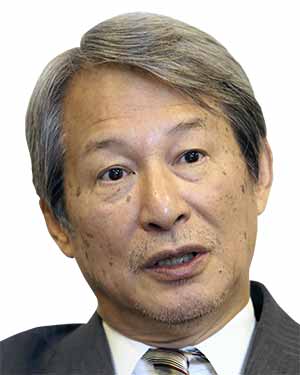18:08 JST, December 2, 2022
Prime Minister Fumio Kishida declared in his policy speech to the Diet in October that his administration “will formulate the new National Security Strategy by the end of this calendar year.” To defend “the peace and stability of Asia and the world,” he pledged to examine the contents essential for “the fundamental reinforcement of our defense capabilities within five years.” To make that possible, he added, his administration will press ahead in an integrated, vigorous manner in assessing the required budgetary scale and securing the necessary fiscal resources. His policy commitment was timely and important indeed.
The world order is undergoing a huge transformation. Russia has invaded Ukraine, trampling on the international norm that any unilateral change to the status quo by force cannot be tolerated. Should Moscow use nuclear weapons, it would breach another international norm that constrains countries from employing nuclear weapons on par with conventional ones. North Korea, for its part, has been continuing its flurry of missile launches while deploying tactical battlefield nuclear weapons, as reported by Pyongyang’s state media.
In China, President Xi Jinping consolidated his power further in October’s National Congress of the Chinese Communist Party. As for Beijing’s ambition to “reunite” Taiwan, he declared, “… we will never promise to renounce the use of force, and we reserve the option of taking all measures necessary.”
The congress agreed to include in the CCP Constitution statements on “elevating our people’s armed forces to world-class standards” and “strengthening the military through … science and technology.”
In August, under the pretext of protesting U.S. House Speaker Nancy Pelosi’s visit to Taiwan, China staged massive military exercises rehearsing a blockade of the self-governed island. The Chinese armed forces have since established a new normal of repeating what seems to be military activities amounting to simulated warfare around Taiwan.
If and when a contingency or military conflict occurs in Taiwan, Japan will almost certainly be in an emergency situation as well. Such a situation can be said to be “tantamount to a national crisis.” There is a legitimate worry that what is happening in Ukraine may happen “tomorrow in East Asia.”
How then should we think of Japan’s national security strategy?
What is most important is to strengthen Japan’s overall power by not only integrating military capabilities in the domains of land, sea and air with new ones such as cyberspace, electromagnetic waves and outer space, but also by integrating military and civilian capabilities: the economy, science and technology, information and other elements.
Only after combining these capabilities will it be possible for Japan to realize its security and prosperity and do its share in defending a “free and open Indo-Pacific” and the world.
As regards the budget, the government should break with the tradition of defining the Defense Ministry’s budget alone as the country’s defense expenditures. It should instead identify defense-related expenditures beyond ministerial and agency boundaries to integrate them into a cross-ministerial/agency “defense-related budget” pool as part of its efforts to strengthen the country’s defense capabilities.
The key question is which capabilities should be strengthened in order to build a defense system that is comprehensive and efficient in mobilizing the country’s resources.
Deterrence, response capabilities
Four points are vital for enhancing Japan’s defense capabilities.
First, Japan needs to strengthen its deterrence and response capabilities.
To begin with, it has to develop counterstrike capabilities, such as launching long-range stand-off missiles to disable targets from outside an adversary’s range. Next, it should introduce a system enabling fighter jets and naval vessels of both the Self-Defense Forces and the U.S. military to use civil airports and seaports in the event of an emergency and improve such infrastructure as required. Japan must ensure its sustainment ability. It should set up a surveillance network of numerous small satellites, also known as a satellite constellation, and develop unmanned aircraft systems while improving the ability to operate these UAS. Japan has to immediately implement these solutions.
The government should procure defense equipment in such a way as to make Japan’s military capabilities complement those of the United States. It should also introduce institutional reforms to achieve three very important defense-related requirements: the establishment of permanent joint headquarters responsible for the central command of operations of the Ground, Maritime and Air Self-Defense Forces; strengthening coordinated operations of Japanese and U.S. forces; and formulation of a “joint operation plan” for Japan and the United States to facilitate their integrated operations in the event of an emergency in Taiwan.
The second vital point is Japan’s ability to respond to gray areas. Cyber-attacks can happen at any time. There is an urgent need for the country to reinforce its cybersecurity capabilities.
Given that Chinese government ships have repeatedly intruded into Japanese territorial waters around the Senkaku Islands in Okinawa Prefecture, it is important to bolster the Japan Coast Guard’s capabilities and greatly enhance response coordination between the JCG and the SDF by making them improve their “seamless” emergency response, sharing of information and cooperation mainly through joint training. In the South China Sea and around Taiwan, China has been demonstrating its coercive power while stopping short of resorting to military means. This is a threat to Japan and should be considered part of the country’s security strategy.
In the 2010s, China drove fishing boats and government ships of member states of the Association of Southeast Asian Nations out of the South China Sea to build and fortify man-made islands there. If China organizes military exercises around Taiwan to impose a de facto maritime blockade of the self-governing democracy, such a development constitutes a gray-zone situation that is tantamount to an emergency.
Considering the importance of Taiwan and the South China Sea, Japan’s efforts to formulate a new National Security Strategy have to also factor in countermeasures that are indispensable to cope with these gray-zone situations. There are approaches that can be pursued immediately, such as an arrangement with Taiwan to share information during peacetime and the provision to ASEAN member states of maritime security information covering the South China Sea.
Work with trusted strategic partners
The third vital point is the utilization of the defense equipment transfer policy. Japan has signed defense equipment and technology transfer agreements with 12 countries, including its ally, the United States, and its de facto allies such as Australia and the United Kingdom, as well as five ASEAN member states and India. Nevertheless, it has so far managed to export finished defense equipment abroad only once — air surveillance radar systems shipped to the Philippines.
In Japan, company after company has been withdrawing from defense-related businesses. There is much debate proposing defense equipment transfer schemes as an incentive for promoting defense-related businesses. The debate itself is not off the mark. It should not be forgotten, however, that defense equipment transfers are the key to successful security cooperation with trusted strategic-partner nations. Japan should revise the related regulations to enable frigates and fighter aircraft, among other equipment, to be provided to trusted countries located in areas of strategic importance in the Indo-Pacific. Japan has begun coordination with the United Kingdom for jointly developing a next-generation fighter jet. Similar projects should be undertaken with Australia, among other trusted countries.
The fourth vital point is economic security. Japan should accelerate public-private cooperation to upgrade research and development capabilities for leading advanced technologies, particularly in fields such as outer space, maritime, cyber, artificial intelligence, UAS and quantum mechanics.
The United States, China, and European countries are making massive investments in the promotion of basic research and the development of advanced and emerging technologies because they are the key to future industrial growth and have the potential to cause a sea change in the way future warfare is conducted. Depending on who uses it, technology can be applied for civilian or military purposes. So long as universities in Japan decline to carry out such dual-use research, off-campus research projects should be pursued under the leadership of the National Security Council and the Council for Science, Technology and Innovation. In such research activities, it is very important to cooperate with research institutes and teams in trusted foreign countries. To facilitate such cooperation, Japan needs to implement a system — including ensuring that the relevant Japanese personnel have the appropriate level of national security clearance to be given authorization to access classified information — that must be aligned with the related standards adopted by its ally and de facto allies.
The main theme of the new National Security Strategy is to strengthen and enhance Japan’s deterrence capabilities as a whole so as to contribute to the stability of the Indo-Pacific and the world. To that end, the country should press ahead with the integration of military capabilities and the integration of military and non-military capabilities. Further, it is imperative for Japan to strengthen its alliance with the United States and partnerships with trusted strategic-partner nations. “Integration,” “deterrence” and “trust” are the key concepts in the new security strategy.

Takashi Shiraishi
Shiraishi is the chancellor of the Prefectural University of Kumamoto. Previously, he was the president of the National Graduate Institute for Policy Studies from 2011-17 and the president of the Institute of Developing Economies, Japan External Trade Organization, from 2007-18.
"Editorial & Columns" POPULAR ARTICLE
-

Violations of Subcontract Law: Major Automakers Must Eliminate Old Practices
-

Local Governments’ Tax Revenues: Devise Ways to Correct Imbalances in Tax Sources
-

5 Japanese Business Dinner Mistakes to Avoid — and What They Taught Me About Business in Japan
-

Heavy Rains in Asia: Support for Victims, Flood-Control Measures Urgently Needed
-

New Nuclear Threat: China Seeking to Follow U.S., Russia in Military Expansion
JN ACCESS RANKING
-

Keidanren Chairman Yoshinobu Tsutsui Visits Kashiwazaki-Kariwa Nuclear Power Plant; Inspects New Emergency Safety System
-

Imports of Rare Earths from China Facing Delays, May Be Caused by Deterioration of Japan-China Relations
-

University of Tokyo Professor Discusses Japanese Economic Security in Interview Ahead of Forum
-

Japan Pulls out of Vietnam Nuclear Project, Complicating Hanoi’s Power Plans
-

Govt Aims to Expand NISA Program Lineup, Abolish Age Restriction

























